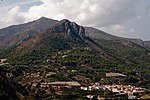Barony of Polop

The Barony of Polop and Benidorm is an ancient Spanish hereditary lordship in the Kingdom of Valencia under the Crown of Aragon (in Spanish, baronía señorial aragonesa). The barony, including the castles of Polop and Benidorm and extensive land, is located in the province of Alicante, Valencia, Spain, only a few miles from the Mediterranean Sea. After being possessed by the Crown of Aragon, in 1429 the barony was bestowed by King John II of Aragon, father of King Ferdinand of Spain the Catholic upon the Fajardo de Mendoza family. The most notable Barons of Polop are the Infantes of Aragon and Doña Beatriz Fajardo de Mendoza y Guzmán, Lady of Albudeyte. Other people associated with the Barony include the Castilian nobleman Don Rodrigo Díaz de Vivar, better known as El Cid Campeador.
Excerpt from the Wikipedia article Barony of Polop (License: CC BY-SA 3.0, Authors, Images).Barony of Polop
Plaça Pintor José Ginés,
Geographical coordinates (GPS) Address Nearby Places Show on map
Geographical coordinates (GPS)
| Latitude | Longitude |
|---|---|
| N 38.622222222222 ° | E -0.12722222222222 ° |
Address
Plaça Pintor José Ginés
Plaça Pintor José Ginés
03520
Valencian Community, Spain
Open on Google Maps








